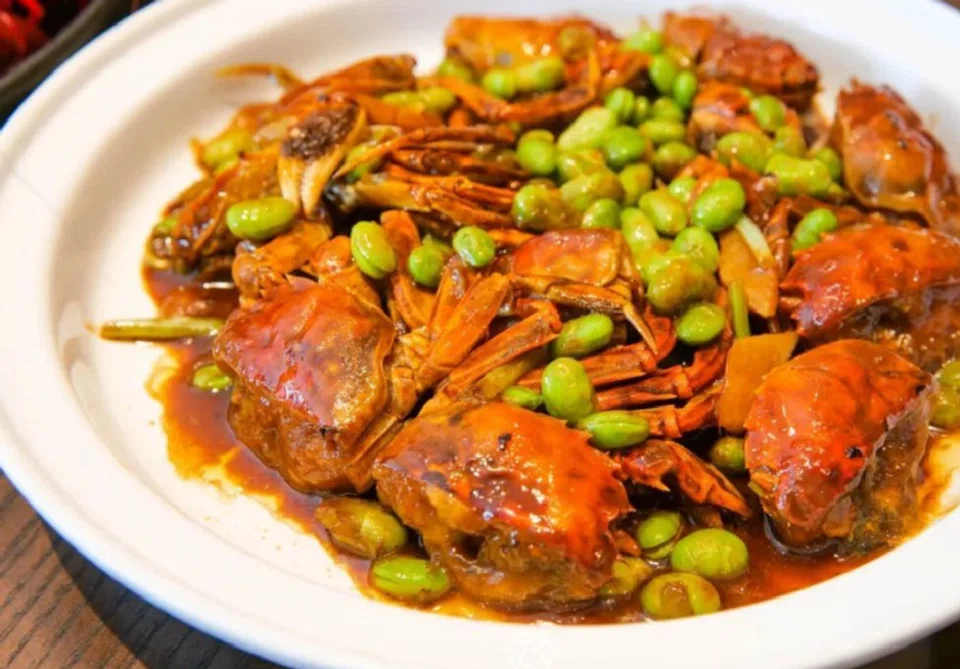Remembering a mother's beautiful smile and Suzhou's 'Sixth Moon yellow' crabs

When I visited Suzhou last week, my friends told me that the liuyuehuang (lit. "Sixth Moon yellow") crabs were back in season and invited me to dinner for a taste. Heading to Suzhou in summer is never a good idea because of the weather; I was prepared to suffer under the merciless heat. But as luck would have it, there was air-conditioning everywhere; it was nearly 40 degrees Celsius outdoors, but it felt as if a gentle spring breeze was caressing my face. Times have changed, but seasonal delicacies haven't - I count myself lucky to have a friend who reminds me about a forgotten delicacy, who tells me that the liuyuehuang crabs are waiting for me in Suzhou.
The "Sixth Moon" in "Sixth Moon yellow" refers to the sixth month in the Chinese lunar calendar, not the solar calendar. Based on the solar calendar, it would be around July and August in the hot summertime. This is when young hairy crabs molt, that is, shed their hard shells, and paddle in the waters of Yangcheng Lake. They go wherever the lake takes them, going with the flow and enjoying their youthful, carefree days. We, modern people, follow the Gregorian solar calendar and thus mistake the liuyuehuang crabs as a delicacy of the early summer, when they are actually associated with the dog days of summer. I am glad that my friend reminded me about the crab season. It was like manna - I mean, hairy crabs - falling from heaven.

Put plainly, liuyuehuang refers to hairy crabs that are not fully mature - they are hairy crabs that are cute, young, and tender. Some use the term "spring crab" à la "spring chicken" to describe their youth, but that is quite inappropriate. These hairy crabs have already gone through three rounds of molting and lived through their adolescence. Thus, they can be said to have metamorphosed and hit puberty. These crabs are no longer young and innocent - right now, they weigh around 100g and are filled with thick and velvety roe - they are in fact in their prime to be savoured at the dining table.
The main idea is to have a taste of the crab's tender fresh meat and luscious roe, which somewhat has the charm of "a cold morning breeze and a waning moon at dawn upon the willow bank" as per a Song Dynasty poem.
Suzhou people are very particular when it comes to eating liuyuehuang. It is most commonly dipped in flour and fried (面拖六月黄 miantuo liuyuehuang), or stir-fried with rice cakes. The main idea is to have a taste of the crab's tender fresh meat and luscious roe, which somewhat has the charm of "a cold morning breeze and a waning moon at dawn upon the willow bank" as per a Song Dynasty poem. Everything is measured and not overdone. It is unlike crab-eating in the late autumn, where people devour crabs weighing 250g, and vow to wolf down an entire lake of crabs.

I spent three days in Suzhou, and had liuyuehuang crabs for dinner on all days. Dinner on the first two nights was arranged by Ah Ji and Laowang, who knew that we wanted to eat crabs. Dinner on the third night was at the invitation of Sheng Xiaoyun, the queen of pingtan music (评弹, a form of musical storytelling). Our dinner appointment was agreed upon long ago, and we ate at Songhelou restaurant on Guanqian Street. We were also served a plate of miantuo liuyehuang to have a taste of the seasonal delicacy in its full glory.
Sheng didn't know that we wanted to eat liuyehuang and specially explained the dish to us when it was served. She said that the liuyehuang is a seasonal delicacy in Suzhou that is only available at this time of the year. She had specially requested for larger and plumper crabs that weighed around 125g just so we could be served the crème de la crème. I immediately felt the warmth and hospitality Suzhou people had for their guests. Not only were they incredibly thoughtful, but they also insisted on only serving them the best.
The biggest difference between a liuyehuang and a mature hairy crab is their age. As the liuyehuang is much younger than a mature crab, it is naturally more docile and less aggressive and feisty than a mature one. Served on the dining table, its shell is crunchier and legs are softer. Its texture is in between that of a mature crab and a soft-shell crab. Its meat is sweet and tender, and its roe creamy. It is a delectable dish indeed.

The miantuo liuyehuang is an easy dish to cook - the key is in choosing seasonal young crabs and garnishing them with fresh edamame. After washing the crabs, cut them in half and remove their stomachs and gills. Then, pour three tablespoons of oil into a hot wok. When the oil is 70% warm, dip the crabs in flour and fry them until golden brown. Pour yellow wine into the wok to get rid of the crab's fishy taste, and stir fry with green onions, ginger, and edamame. Add water until it covers the crabs and season with salt and sugar. After the water boils, switch to medium heat and simmer for ten minutes. Mix the leftover flour with water and pour the batter into the wok to thicken the sauce. Stir fry continuously until the sauce is reduced. When the sauce and crab roe becomes one, the aromatic dish is ready to be plated and served.
The miantuo liuyehuang is cooked in the same way as the miantuo hairy crab - there's nothing fancy about it. There's no need to trouble a celebrity chef from a Michelin star restaurant to cook it at all. Honestly speaking, this is a dish that anyone can cook at home - I, for one, know how to cook it, and boy does it look fit for a restaurant! You only need to have the beautiful and tender liuyehuang as the star of the dish and it'll look like the ones I had in Suzhou.

How did I learn to cook them, you may ask. Ah, that would stir up the melancholy I've kept buried in my heart for a long time, because I learnt it from my mother when I was a child.
I loved eating crabs when I was young. My mother learnt how to make miantuo crabs from a good friend in Shanghai, sometimes with sea crabs, and other times with hairy crabs. She skilfully cooked the dish and served it on the dining table. She didn't eat them herself but watched eagerly as her children tucked into them.
I still remember the warmth in her eyes as she looked at just how happy her children were when they ate the crabs she cooked. She even had to help us deshell the crabs in the end! We often made a mess when we ate, and had sauce all over our hands and faces. But Mother smiled. Her smile looked so happy and so beautiful. Every time she cooked, I was practically her shadow, waiting to eat the delicious dishes afterwards. As the days went by, I learnt how to cook as well.
She passed away many years ago. But eating liuyehuang in Suzhou last week, I remembered my mother's cooking and her beautiful smile like it was yesterday.
